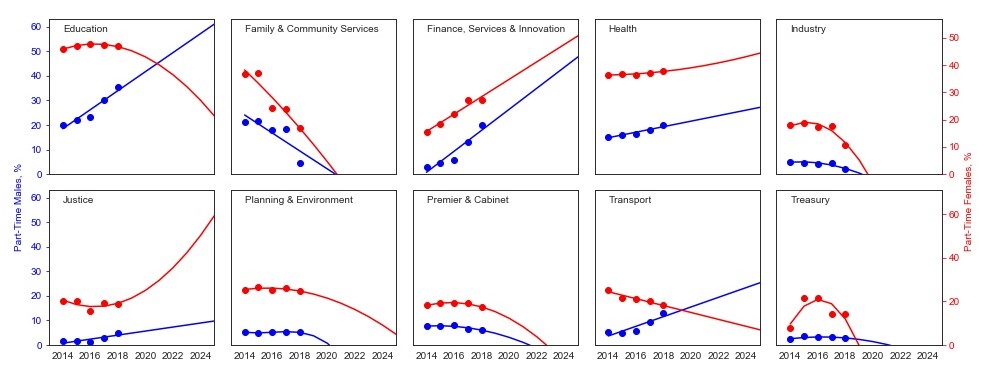In the Data Analysis case study under the Virtual Internship Program of the NSW Government (c/o InsideSherpa), I analysed part-time employment to brief the Director before a meeting with the Workforce Diversity Steering Committee. The meeting aimed to review whether part-time employment arrangements are increasing.
My aim in this internship was to provide:
- Trends over time in male and female employment, including any notable changes
- The current representation of part-time employees in the sector and each cluster
- The current representation of male and female part-time employees as a proportion of the respective male and the female workforce in the sector and each cluster
- Change in these two above statistics over the last 4 years
- Projection of what the representation will be by 2025 if the current trends continue
For the data analysis, I performed the following:
- Explored the dataset
- Determined the variation of male and female employment in the sector from 2014 - 2018
- Obtained the proportion of part-time employees in the sector and each cluster in 2018
- Obtained the proportion of male and female part-time employees in the sector and each cluster in 2018
- Determined the variation of the proportion of male and female part-time employees in the sector and each cluster over time (2014 - 2018)
- Forecasted the variation of the proportion of male and female part-time employees in the sector and each cluster over time (2014 - 2025)
The results show that:
- Male employment in the NSW government indicates upward trend from 2014 - 2018, while female employment shows downward trend. The government employed more women than men in this period.
- In 2018, part-time employees comprised 29.6% of the sector workforce. The clusters of
Education,Health, andFinance, Services & Innovationhave the highest representation of part-time employees in 2018. Meanwhile, the clusters ofIndustry,Treasury, andJusticehave the lowest representation of part-time employees in 2018. - About 16.5% of males and 36.7% of females in the sector are part-time employees in 2018.
Education,Finance, Services & Innovation, andHealthhave the highest representation of male part-time employees in 2018. Meanwhile,Industry,Treasury, andFamily & Community Serviceshave the lowest representation of male part-time employees in 2018. For the representation of female part-time employees in 2018,Education,Health, andFinance, Services & Innovationshow the highest values whileIndustry,Treasury, andFamily & Community Servicesindicate the lowest. - The proportion of males as part-time employees in the sector increased from 2014 - 2018. From the upward trend, male part-time employees could reach 26.8% by 2025. On the other hand, the proportion of females as part-time employees in the sector peaked in 2017 and could decrease to 29% by 2025.
- For the employment of part-time males, 5 out of the 10 clusters (
Education,Finance, Services & Innovation,Health,Justice, andTransport) are predicted to hire more until 2025. For the employment of part-time females, all clusters exceptFinance,Services & Innovation,Health, andJusticeare forecasted to hire less until 2025 (see figure below).
For more details, please see the Data Analysis - Data Sheets.xlsx Excel file and the full data analysis in the Project_NSW.ipynb notebook above.
